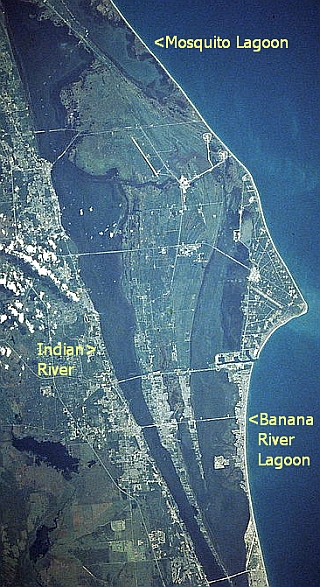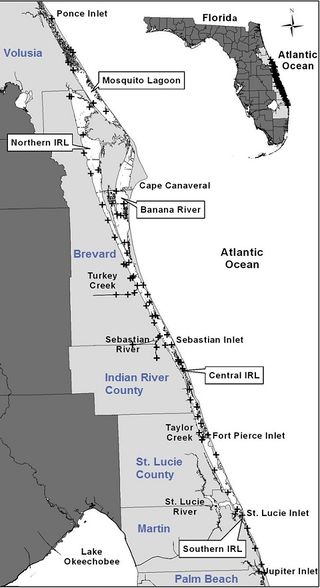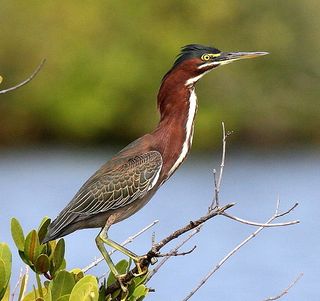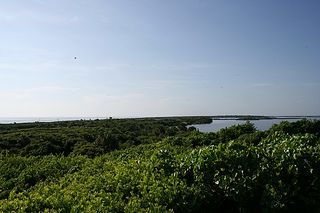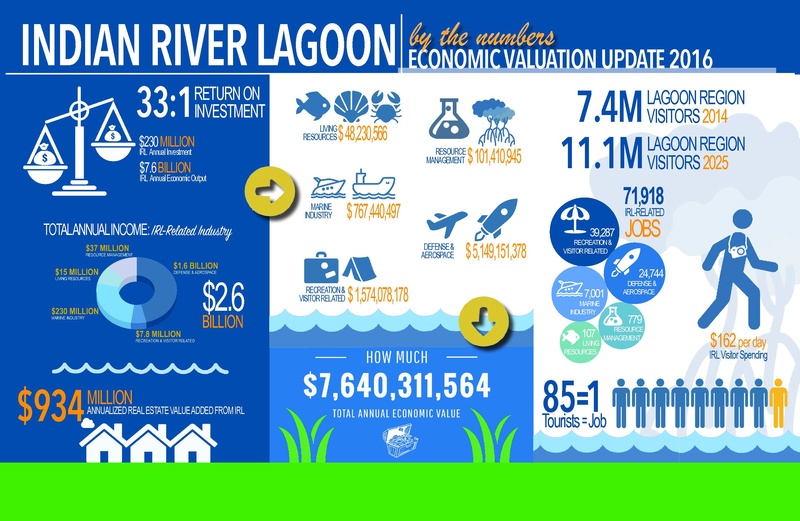Indian River Lagoon Estuary
The Indian River Lagoon National Estuary is the most bio-diverse natural habitat in North America.[1]
Indian River Lagoon National Estuary
From it's northern boundary at Volusia's Ponce de Leon Inlet, the 156 mile long Indian River Lagoon National Estuary spans across 6 counties, to it's southern boundary at Palm Beach County's Jupiter Inlet.
Within the Indian River Lagoon's boundaries are 5 Atlantic Ocean Inlets, 5 State Parks, 4 National Wildlife Refuges, a National Seashore, an Intracoastal Waterway, a Navy Submarine Base, a Space Force Base, and a National Space Center.
In 1990, the Indian River Lagoon was chosen as an Estuary of National Significance and assigned to the National Estuary Program (NEP) by the United States Environmental Protection Agency (EPA).
The Indian River Lagoon National Estuary Program (IRLNEP) is currently managed by the IRL Council, a special district of the State of Florida.
Geography
Averaging only 4' in depth and .5 to 5 miles wide, the 156 mile long Indian River Lagoon National Estuary covers 2,284 square miles, with a surface water area of 353 square miles.[1]
The brackish, bar-built estuary merges 5 freshwater rivers and 5 saltwater inlets, into 3 main water bodies, the Mosquito, Banana River, and Indian River Lagoons.
Mosquito Lagoon
Template:IRL Mosquito Lagoon Tributaries
The IRL NEP's range begins at the northern tip of Mosquito Lagoon, with Volusia County's Ponce De Leon Inlet. Mosquito Lagoon then spans Brevard County, where it connects to the Indian River through Haulover Canal.
An outdoor lover's paradise, Mosquito Lagoon is bounded on the west by the Merritt Island National Wildlife Refuge (NWR), on the east by Canaveral National Seashore, and by Kennedy Space Center on the south.
Banana River
Template:IRL Banana River Tributaries
The Banana River lagoon begins at Banana Creek, near Titusville, spans south thru the Kennedy Space Center (KSC), to merge with the Indian River at the southern tip of Merritt Island, Dragon's Point.
The middle section of the Banana River lagoon lies within KSC property and is closed to the public. Port Canaveral, at KSC's southern boundary, provides minor saltwater inflow when the locks are open.
The Canaveral Locks, channel, and barge canal allow sea going vessels to access the Banana River (KSC deliveries), or take the channel westward across the river, transverse Merritt Island's Barge Canal, and access the Intracoastal Waterway (ICW) in the Indian River.
Indian River
Template:IRL Indian River Tributaries
From it's northern boundary in Brevard's Scottsmoor, the 121 mile long Indian River extends southward thru five Florida counties. Along the way, the river connects with the Atlantic Ocean at Sebastian, St. Lucie, Fort Pierce, and Jupiter inlets.
The Indian River receives fresh water from the Eau Gallie, Sebastian, St. Lucie, and Loxahatchee rivers, plus many small feeder creeks. Lake Okeechobee connects to the Indian River in St. Lucie county, via the Okeechobee Waterway and the St. Lucie River.
The southern boundary of the Indian River Lagoon National Estuary is at Martin County's Sewall's Point, where it meets Palm Beach County's Jupiter Inlet.
Biota
Home to more than 2,100 plants and 2,200 animal species, the Indian River Lagoon National Estuary is the most bio-diverse habitat in North America.[1]
The estuary contains many diverse natural habitats, from sea grass flats and mangrove shorelines to upland forests, that accommodate a vast array of plant and animal species. The estuary's saltwater inlets and freshwater tributaries blend together to form the lagoon's brackish water, which provides an unique habitat, where plants and animals from both salt and fresh water habitats can reside.
Some species, including Johnson's Seagrass and the Atlantic salt marsh snake, are found no where else on earth. The IRL estuary is home to 35 plant and animal species that are listed as threatened or endangered under the Endangered Species Act, more than any other estuary in North America.[1] .
Habitat
Because the Indian River Lagoon National Estuary is located in an area where tropical and temperate climates meet, it's over 4,000 plant and animal species include native subtropical and tropical residents, plus many migratory winter visitors. The estuary's diverse habitats, including freshwater tributaries, spoil islands, salt marshes, seagrass flats, oyster bars, mangroves, shorelines, and sandy pine forests, provide homes for both aquatic and terrestrial plants and animals.
Flora
Mangrove forests provide shoreline protection, water purification, and nurseries for small fish, shrimp and crab. Seagrasses are a critical component to the overall health of the lagoon.
Fauna
The estuary serves as a spawning and nursery ground for many different species of salt and brackish water fish and shellfish. Aquatic animals such as alligator, sea turtle, dolphin, manatee, fresh and saltwater fish forage in the seagrass flats. Red Drum, Spotted sea trout, Common snook, and Tarpon are the main gamefish found in the estuary's lagoons.
Nearly 1/3 of the nation's manatee population lives in the estuary or migrates through the area seasonally. Between 200 and 800 Bottlenose dolphins (Tursiops truncatus) live year-round in the Mosquito, Banana River and Indian River lagoons.[2] At night the lagoons are lit up with bioluminescent dinoflagellates in the summer and ctenophore in the winter.
In the Merritt Island National Wildlife Refuge, a world class birding destination, many types of shorebirds, waterfowl and wading birds, like the Roseate spoonbill, Snowy egret, and Brown pelican, can be seen feeding on shrimp, crustaceans and mollusks near the shorelines and Mangrove covered spoil islands. Birds of prey including kites, hawks, osprey, owls, eagles feed on reptiles and rodents or fish.
Higher up, in the sandy palmetto and pine uplands, the terrestrial animals might include boar, panther, bobcat, deer, raccoons, oppossum, Nine-banded armadillo and Florida Gopher tortoise.
History
During glacial periods, the ocean receded. The area that is now the lagoon was grassland, 30 miles from the beach. When the glacier melted, the sea rose. The lagoon remained as captured water.[3]
The indigenous people who lived along the lagoon thrived on its fish and shellfish. This was determined by analyzing the middens they left behind, piled with refuse from clams, oysters, and mussels.[3]
The Indian River Lagoon was originally known on early Spanish maps as the Rio de Ais, after the Ais Indian tribe, who lived along the east coast of Florida. An expedition in 1605 by Alvero Mexia resulted in the mapping of most of the lagoon. Original place names on the map included Los Mosquitos (the Mosquito Lagoon and the Halifax River), Haulover (current Haulover Canal area), Ulumay Lagoon (Banana River) Rio d' Ais (North Indian River), and Pentoya Lagoon (Indian River Melbourne to Ft. Pierce)
Early European settlers drained the swamps to raise pineapples and citrus. They dug canals discharging fresh water into the lagoon, five times the historical volume.[3]
Prior to the arrival of the railroad, the river was an essential transportation link.
In 1896 and 1902, there were fish kills in the lagoon from gas from the muck below.
The advent of the automobile, starting in the 1930s, resulted in causeways which diverted the sluggish flow of the waterway. Huge population influx resulted in sewage, and stormwater runoff from roadways, polluting the lagoon.[3]
From 1989 to 2013, the population along the lagoon increased 50% to 1.6 million people.
Timeline
In 1916, the St. Lucie Canal (C-44) diverts excess nutrient-rich water from Lake Okeechobee into the South Lagoon. While this helps prevent life-threatening flooding in the Okeechobee area, it creates toxic blooms after entering the Lagoon, a threat to flora, fauna, and humans. This situation is proving difficult to address in the 21st century.[3]
From 1913 to 2013, activity by humans has increased the watershed for the lagoon from 572000 to 1400000 acres increasing runoff of freshwater and nutrients from farms. Both have been detrimental to lagoon health. The wetlands are needed to cleanse the lagoon. About 40000 acres of land were lost to mosquito control and have been restored, but by 2013, recovery was incomplete.
Mangroves are a keystone species that help prevent shoreline erosion and provide critical habitat for marine life. Between the 1940s and 2013, 85% of them had been removed for housing development.
In 1986, there were 46 sewer plants along the 156 mile lagoon. They discharged about 55000000 gallons daily into the estuary.
In 1990, the Florida Legislature passed the Indian River Lagoon Act, requiring most sewer plants to stop discharging into the lagoon by 1996.
Some sports fish rebounded in population in the 1990s when gill nets were banned and pollution in the lagoon was reduced. In 1995 the seagrass covered over 100000 acres.[4]
In 2007, concerns were raised about the future of the lagoon system, especially in the southern half where frequent freshwater discharges seriously threatened water quality, decreasing the salinity needed by many fish species, and have contributed to large algae blooms promoted by water saturated with plant fertilizers. In the mid 1990s, the lagoon has been the subject of research on light penetration for photosynthesis in submerged aquatic vegetation.[5]
In 2010, 3300000 lbs of nitrogen and 475000 lbs of phosphorus entered the lagoon.
In 2011, a superbloom of phytoplankton resulted in the loss of 32000 acres of lagoon seagrass. In 2012, a brown tide bloom fouled the northern lagoon. The county has approval for funds to investigate these unusual blooms to see if they can be prevented.
Catches of blue crabs (Callinectes sapidus) dropped unevenly from 4265063 lb in 1987 to 389,795 lb in 2012, but with high catches in 1998, 1991, alternating with low catch years. These crabs require 2% salt content in the water to survive. A drought increases the salt content and heavy rainfall decreases it. Both of these conditions have recurred over the past decades and are believed to have had an adverse effect on the crab population.[6]
In 2013, algae blooms and loss of sea grass destroyed all gains.
In 2013, four major problems with lagoon water quality were identified.
- Excess nitrogen and phosphorus from runoff from the application of fertilizer;
- an estimated 8 to 11% septic tank failures of tens of thousands of septic tanks in the county.
- Muck from construction, farming, erosion and dead plants find their way to the bottom of the lagoon, preventing growth and consuming vital oxygen essential to marine flora and fauna;
- Invasive species, including the Asian green mussel, South American charru mussel, and the Australian spotted jellyfish (Phyllorhiza punctata), eat clams and fish larvae.
In 2016, there were an estimated 300,000 septic tanks in the five-county area bordering the Lagoon.
In 2018, lagoon health is better near ocean inlets. Pollution is worse in areas with no inlets, such as the Mosquito Lagoon, North IRL, and the Banana River.[3]
Human Impact
The Indian River Lagoon National Estuary spreads across Volusia, Brevard, Indian River, St. Lucie, Martin, and Palm Beach counties with a rapidly growing population of 1.5 million residents. Waterfront residents enjoy a panoramic view, a parade of watercraft, unique wildlife sightings, and private boat docks with instant water access. Condominium dwellers enjoy well manicured landscaping, large paved parking lots and a convenient shopping plaza nearby. Human impact from inadequate sewer utilities, seeping septic tank drain fields, stormwater run-off polluted with lawn fertilizer, and excessive wetland development has drastically affected the estuary's health.
The result of this adverse human impact could be seen in a 2016 green algae outbreak. Fueled by an excess of phosphorous and nitrogen, the blooming algae growth created a lack of oxygen in the water, that caused widespread fish kills across Florida's east coast. The harmful_algae_bloom (HAB) rendered parts of the estuary unusable; turned lush waterfront real estate into undesirable neighborhoods; created respiratory health problems for residents; killed many plants and animals; and completely devastated the local ecotourism industry.
The recent Economic Valuation Study reported that for every $1 spent restoring the estuary, $33 would be returned to the local economy.[7]
Economy
A healthy estuary is a vital economic factor in Florida's East Coast communities. The estuary provides direct income for resident's who work both on and off the water. Commercial fishing, ecotourism, outdoor equipment retail, watercraft sales/service, and marina industries all directly depend on the estuary for income. Indirectly, the economic success of the above industries also increases earnings for local tourism, hospitality, transportation and real estate industries. A 2016 Economic Valuation Study, conducted by Hazen and Sawyer water consultants for the St. John Water Management District (SJWMD), estimated the Indian River Lagoon Estuary's economic value at $7,640,311,564 per year.[7]
Restoration and Preservation
In 2016, the citizens of Brevard County voted in a .5% sales tax increase to fund a program to restore and preserve the Indian River estuary. Brevard's Save Our Indian River Lagoon (SOIRL) trust has received over $114 million in sales tax revenue to date (2019). Directed by the Brevard County Natural Resources Department, overseen by the Citizen Oversight Committee (COC), counseled by the NEP's IRL Council[8], and guided by scientists from the Indian River Lagoon Research Institute (IRLRI) at Florida Institute of Technology (FIT), the SOIRL currently has several restoration projects underway.[9]
The 2019 SOIRL Project Plan[10] includes:
Web Links
- IRL Economic Valuation Brochure
- DEP Indian River Lagoon Watershed
- Florida Today:From the Water: Healing our Lagoon
- National Estuary Program Brochure (PDF 11pp 2.83MB)
- NOAA Estuary Education Kit
- EPA - An Introduction to a National Treasure (PDF 40pp 4.09MB)
References
- ↑ 1.0 1.1 1.2 1.3 An Introduction to a Natural Treasure
- ↑ Indian River Lagoon Estuarine System Stock - Bottlenose Dolphin
- ↑ 3.0 3.1 3.2 3.3 3.4 3.5 A History of the Lagoon
- ↑ Seagrass biodiversity in the Indian River Lagoon
- ↑ Continuous Monitoring of Underwater Light in Indian River Lagoon: Comparison of Cosine and Spherical Sensors. 1997
- ↑ Lagoon crab catches dwindle (2013)
- ↑ 7.0 7.1 IRL Economic Impact Report 2016
- ↑ Indian River Lagoon National Estuary Program
- ↑ Save Our Indian River Lagoon
- ↑ SOIRL Project Plan 2019
- ↑ Muck Fact Sheet (PDF)
- ↑ Septic Tank Fact Sheet (PDF)
- ↑ Living Shorelines Fact Sheet (PDF)
- ↑ Fertilizer Fact Sheet (PDF)

